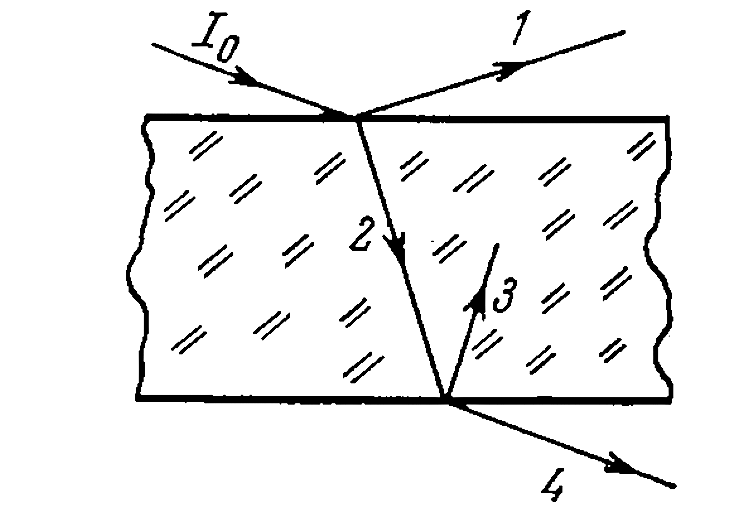Natural light falls at the Brewster angle on the surfcae of glass. Using the Fresnel equations, find
(a) the reflection coefficient,
(b) the degree of polarization of refracted light.
From Fresnel's equations
I'⊥=I⊥sin2(θ1−θ2)sin2(θ1+θ2)I'∣∣=0⎫⎪⎬⎪⎭ at Brewste's angle
I'∣∣=0
I'⊥=I⊥sin2(θ1−θ2)
=12I(sinθ1cosθ2−cosθ1sinθ2)2
Now tanθ1=n,sinθ1=n√n2+1
cosθ1=1√n2+1,sinθ2=cosθ1
cosθ2=sinθ1
I'⊥=12I(n2−1n2+1)2
Thus reflection coefficient =ρ=I'⊥I
=12(n2−1n2+1)20.074
on putting n=1.5
(b) For the refracted light
I''⊥=I⊥−I'⊥=12I{1−(n2−1n2+1)2}
=12I4n2(n2+1)2
I'∣∣=12I
at the Brewster's angle.
Thus the degree of polarization of the refraced light is
P=I''∣∣−I''⊥I''∣∣+I''⊥=(n2+1)2−4n2(n2+1)2+4n2
=(n2−1)22(n2+1)2−(n2−1)2=ρ1−ρ
On putting ρ=0.074 we get P=0.080.
Topper's Solved these Questions
- OPTICSBOOK - IE IRODOV, LA SENA & SS KROTOVCHAPTER - OPTICSEXERCISE - Dispersion And Absorption Of Light
24 Videos
- OPTICSBOOK - IE IRODOV, LA SENA & SS KROTOVCHAPTER - OPTICSEXERCISE - Optics Of Moving Sources
22 Videos
- OPTICSBOOK - IE IRODOV, LA SENA & SS KROTOVCHAPTER - OPTICSEXERCISE - Diffraction Of Light
60 Videos
- MECHANICSBOOK - IE IRODOV, LA SENA & SS KROTOVCHAPTER - MECHANICSEXERCISE - Mechanics Problems
92 Videos
- OSCILLATIONS AND WAVESBOOK - IE IRODOV, LA SENA & SS KROTOVCHAPTER - OSCILLATIONS AND WAVESEXERCISE - Electromagnetic Waves, Radiation
36 Videos
Similar Questions
A beam of natural light falls on the surface of glass at an angle of 45∘. Using the Fresnel equations, find the degree of polarization of
(a) reflected light,
(b) refracted light.
View SolutionUsing the Fresnel equations, find:
(a) the reflection coefficient of natural light falling normally on the surface of glass,
(b) the relative loss of luminous flux due to reflections of a paraxial ray of natural light passing through an aligned aoptical system comprising five glass lenses (secondary reflections o flight are to be neglected).
View Solution
Knowledge Check
Assertion (A) : When an unpolarised light is incident on a glass plate at Brewster angle, the reflected ray and refracted ray mutually perpendicular
Reason (R ) : The refractive index of glass is equal to sine of the angle of polarisation.ABoth 'A' and 'R' are true and 'R' is the correct explanation of 'A'BBoth 'A' and 'R' are true and 'R' is not the correct explanation of 'A'CA' is true and 'R' is falseDA' is false and 'R' is trueA light ray falls on a rectangular glass slab as shown. The index of refraction of the glass, if total internal reflection is to occur at the vertical face, is
 A√3/2B(√3+1)2C(√2+1)2D√5/2
A√3/2B(√3+1)2C(√2+1)2D√5/2
A narrow beam of natural light falls on the surface of a thick transparent plane-parallel plate at the Brewster angle. Its top surface. Find the degree of polarization of beams 1−4 (Fig.)

View SolutionA narrow beam of natural light falls on a set of N thick plane-parallel glass plates at the Brewster angle. Find:
(a) the degree P of polarization of the transmitted beam,
(b) what P is equal to when N=1,2,5, and 10.
View SolutionA plane beam of natural light with intensity I0 falls on the surface of water at the Brewster angle. A fraction ρ=0.039 of luminous flux is reflected. Find the intensity of the refracted beam.
View SolutionA : When an unpolarised light is incident on a glass plate at Brewster angle, the reflected ray and refracted ray are matually perpendicular.
R : The refractive index of glass is equal to sine of the angle of polarisation.
View SolutionWhen sun light is incident at an angle of 53∘ on the surface of water, the reflected light is plane polarized. Calculate the angle of refraction and refractive index of water.
View SolutionA ray of light is incident on the surface of a glass plate of index of refraction 1.55 at the polarizing angle. Calculate the angle of refraction.
View Solution
